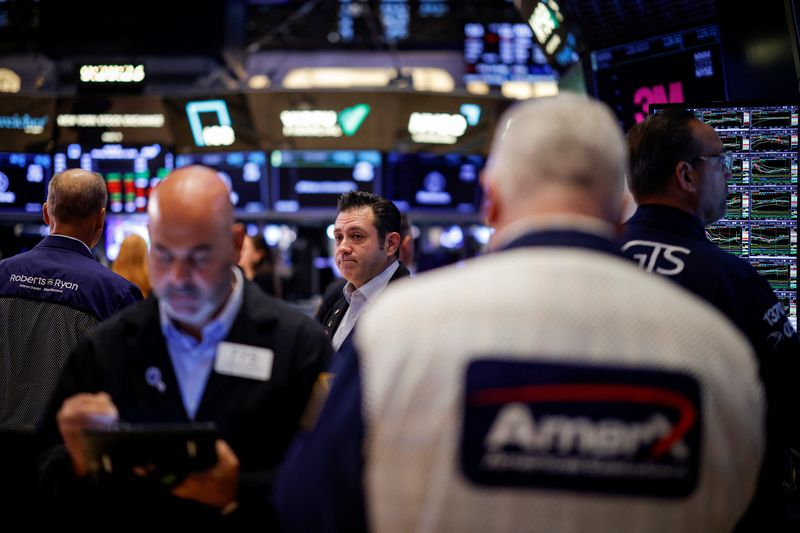(Reuters) - A look at the day ahead in U.S. and global markets from Mike Dolan
With Federal Reserve easing within touching distance, U.S. stocks are not hanging about, underlining an uncomfortable aspect of the central bank's decision this week.
Amid a fresh rotation of sectors from megacaps to small fry, the equal-weighted S&P500, which adjusts the main index to strip away the overwhelming influence of a handful of outsize stocks, hit a record high on Monday.
That index is now up more than 11% for the year and almost 20% over the past 12 months, showing market ebullience is no longer the exclusive preserve of the "Magnificent Seven" of Big Tech leaders or the artificial intelligence theme alone.
But as the Fed starts its two-day meeting on Tuesday and ponders the size of its first interest rate cut of this cycle, the broad loosening of financial conditions caused by this sort of market optimism could play a part in keeping it cautious.
The Chicago Fed's broad financial conditions index, for example, is now at its loosest since November 2021.
Might the Fed just think the market is doing its easing for it and stick to a modest 25 basis point cut for good measure?
The "25 or 50" debate remains the only focus for Wednesday's set piece announcement and the advance speculation will clearly shape how markets themselves will react to the Fed's delivery.
Right now, Fed futures are leaning toward a 50 bp move, with some 42 bps priced early on Tuesday and 120 bps of easing seen over the remainder of 2024.
Morgan Stanley's strategists, for example, think much of the reaction to the eventual outcome will hinge on what the Fed's latest "dot plot" of future policy rate projections indicates.
If the Fed cuts just a quarter and there are no individual policymaker projections for more than 75 bps by yearend, they say, that could be bullish for risk assets by showing a consensus sees the economy doesn't need any more than that.
Another bullish scenario, according to the investment bank, is a 50 bp cut with some dots seeing less that 75 bps of 2024 cuts - a sign the Fed is not sure the economy needs as much as 50 bp but is going to get it anyway.
Flip all of those for more negative scenarios.
And it appears the 50 bp cut is not off the table, whatever the level of dissent there may be within the committee.
Former New York Fed boss Bill Dudley has over the past week called for a 50 bp move to get ahead of the cooling labor market. And White House adviser and former Fed Vice Chair Lael Brainard also underlined that on Monday by saying "it is important to safeguard the important labor market progress we have made."
Markets retained their buoyancy on Tuesday as the Fed is due to get its last economic healthcheck before making its call, with August retail sales and industrial production numbers out later.
The S&P500 benchmark within a whisker of record highs is matched by two-year Treasury yields hovering around two-year lows of 3.55% - more than 180 bps below the current Fed policy rate. The two-to-10 year yield curve has stayed marginally positive to the tune of about 6 bps.
The VIX stock volatility gauge was subdued at 17 just below long-term medians.
And the dollar index weakened again and is just a hair's breadth from the year's low.
With Japan's markets open again on Tuesday, dollar/yen tried to get a foothold back above 140, but the yen's latest surge this week to its best in 15 months has unnerved the Nikkei stock index. The index lost more than 1% on reopening.
European bourses were firmer as central bank easing across the continent is already underway and expected to continue.
LAGGING TECH
Elsewhere, the action was in Big Tech, which underperformed markedly on Monday.
Apple (NASDAQ:AAPL) dropped almost 3% after an analyst at TF International Securities said demand for its latest iPhone 16 models was lower than expected, pointing to shorter delivery times. It held steady overnight, however, and S&P500 stock futures were up smartly ahead of the bell too.
There was better news for Intel (NASDAQ:INTC), which jumped 6% on Monday after news it qualified for as much as $3.5 billion in federal grants to make semiconductors for the U.S. Department of Defense. It then extended those gains after the bell as its contract manufacturing business signed up Amazon (NASDAQ:AMZN)'s cloud services unit as a customer for making custom artificial intelligence chips.
Microsoft (NASDAQ:MSFT), meantime, said its board has approved a new share buy back program of up to $60 billion and a 10% increase in its dividend.
Key developments that should provide more direction to U.S. markets later on Tuesday:
* US August retail sales, industrial production, September NAHB housing sector index, July business/retail inventories; Canada August CPI inflation

* Federal Reserve's Federal Open Market Committee starts two-day policy meeting, decision Wednesday
* US Treasury sells $13 billion of 20-year bonds
(By Mike Dolan, editing by XXXX; mike.dolan@thomsonreuters.com)